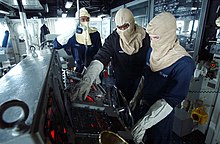|
Anti-flash gear  Anti-flash gear, also known simply as flash gear, is basic personal protective equipment consisting of a fire-resistant hood and fire-resistant gloves,[1] often made of Nomex. The purpose of anti-flash gear is to provide protection to the head, neck, face and hands from short-duration flame exposure and heat. This equipment is donned by shipboard navy personnel whenever a fire breaks out or during periods of heightened readiness.[1] HistoryAnti-flash gear was introduced in the Royal Navy following the Battle of Jutland during the First World War,[2] when a number of British warships had been destroyed or damaged by flash from burning cordite propellant passing through the shell handling room into the magazine. It was found that the anti-flash hoods and gloves were more effective if flame-proofed with borax or boric acid.[3] References
External links
|
Portal di Ensiklopedia Dunia